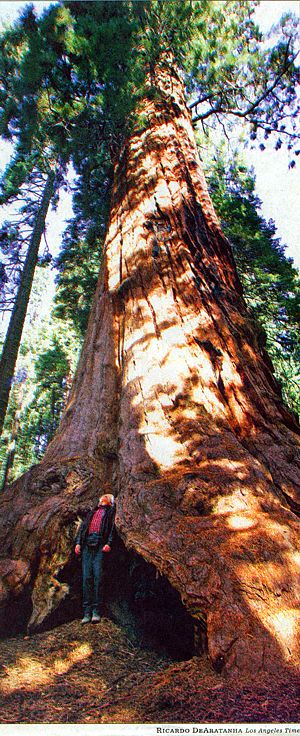Trees live large through the ages
Source of this article – Los Angeles Times, December 14, 2007.

TOWERING OVER: Ara Marderosian stands next to park’s namesake at Giant Sequoia National Monument. The trees stand up to 220 feet tall and are believed to date back up to 1,500 years.
PONDEROSA, Calif. — Morning in Los Angeles. Snarled traffic. Enraged commuters. An excruciatingly slow escape to the open highway.
Polar opposite to an afternoon stroll — on the same early December day — along the Trail of 100 Giants, whose shaded pathway is all but deserted.
The short, meandering trail is named, of course, after the giant sequoias that are interspersed among lesser pines and cedars.
One can apply the term “lesser” in reference to these trees because, while they may be impressive by themselves, they appear as straggly inferiors alongside the stately sequoias.
“I’m in awe,” says Petra Beumer, a visitor from Santa Barbara, as she and Eric Shankula stroll among the highwayside grove. “I come from Germany and we do not have trees nearly this big.”
The Trail of 100 Giants is a must-stop for travelers passing through or near the southern Sierra Nevada, though prospective visitors are advised to wait till spring because the highway closes after the first major snowfall.
It’s within the Giant Sequoia National Monument and the Long Meadow Giant Sequoia Grove, and is most easily accessible from Los Angeles through the Kemville area above Bakersfield.
The paved trail is half a mile long and with only subtle gradients, so visitors in wheelchairs can likewise wander and marvel at one of nature’s most impressive creations.
“I like the way the sun hits them through all the shadows; the colors are brilliant,” says Don Blair, a recent transplant from Los Angeles to nearby Camp Nelson.
“It’s the size and age of them that I find amazing,” adds Gail Martel ofWinnetka in the San Femando Valley.
Some of the trees poke skyward 220 feet and are 20 feet around. They are believed to be between 500 and 1,500 years old.
It’s hard to fathom that elsewhere in this forest there are even larger specimens, such as General Sherman, the largest tree on earth, towering 275 feet, measuring 37 feet around and perhaps having lived 2,500 years or more.
 That places its beginnings at about 500 BC, an era when city-states in Italy and Greece were just beginning to experiment with something called government.
That places its beginnings at about 500 BC, an era when city-states in Italy and Greece were just beginning to experiment with something called government.
Our lives are but a flash by comparison. As I rest on a bench alongside the now-deserted trail and gaze at the nearest sequoia, I watch intently for movement of any kind, but there is none.
I wonder whether it detects my presence, then snap to with the realization that these trees, after all, are simply oversized hulks of wood, filled with sap and adorned with foliage. No brains. No emotion. End of story.
Or is there more to them than that?



0 Comments